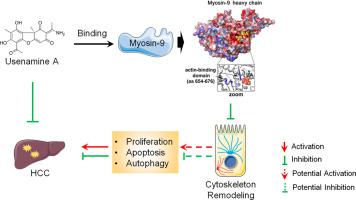Phytomedicine ( IF 6.7 ) Pub Date : 2023-05-20 , DOI: 10.1016/j.phymed.2023.154895 Ailin Yang 1 , Kewu Zeng 2 , Huiming Huang 1 , Dongxiao Liu 1 , Xiaomin Song 2 , Yi Qian 2 , Xuelong Yu 1 , Dan Liu 3 , Xiaojun Zha 4 , Hongbing Zhang 5 , Xingyun Chai 1 , Pengfei Tu 1 , Zhongdong Hu 1

|
Background
Hepatocellular carcinoma (HCC) is a major cause of cancer-associated mortality worldwide. Myosin-9′s role in HCC and the anti-HCC effect of the drugs targeting Myosin-9 remain poorly understood so far. Candidate antitumor agents obtained from natural products have attracted worldwide attention. Usenamine A is a novel product, which was first extracted in our laboratory from the lichen Usnea longissima. According to published reports, usenamine A exhibits good antitumor activity, while the mechanisms underlying its antitumor effects remain to be elucidated.
Purpose
The present study investigated the anti-hepatoma effect of usenamine A and the underlying molecular mechanisms, along with evaluating the therapeutic potential of targeting Myosin-9 in HCC.
Methods
The CCK-8, Hoechst staining, and FACS assays were conducted in the present study to investigate how usenamine A affected the growth and apoptosis of human hepatoma cells. Moreover, TEM, acridine orange staining, and immunofluorescence assay were performed to explore the induction of autophagy by usenamine A in human hepatoma cells. The usenamine A-mediated regulation of protein expression in human hepatoma cells was analyzed using immunoblotting. MS analysis, SPR assay, CETSA, and molecular modeling were performed to identify the direct target of usenamine A. Immunofluorescence assay and co-immunoprecipitation assay were conducted to determine whether usenamine A affected the interaction between Myosin-9 and the actin present in human hepatoma cells. In addition, the anti-hepatoma effect of usenamine A was investigated in vivo using a xenograft tumor model and the IHC analysis.
Results
The present study initially revealed that usenamine A could suppress the proliferation of HepG2 and SK-HEP-1 cells (hepatoma cell lines). Furthermore, usenamine A induced cell apoptosis via the activation of caspase-3. In addition, usenamine A enhanced autophagy. Moreover, usenamine A administration could dramatically suppress the carcinogenic ability of HepG2 cells, as evidenced by the nude mouse xenograft tumor model. Importantly, it was initially revealed that Myosin-9 was a direct target of usenamine A. Usenamine A could block cytoskeleton remodeling through the disruption of the interaction between Myosin-9 and actin. Myosin-9 participated in suppressing proliferation while inducing apoptosis and autophagy in response to treatment with usenamine A. In addition, Myosin-9 was revealed as a potential oncogene in HCC.
Conclusions
Usenamine A was initially revealed to suppress human hepatoma cells growth by interfering with the Myosin-9/actin-dependent cytoskeleton remodeling through the direct targeting of Myosin-9. Myosin-9 is, therefore, a promising candidate target for HCC treatment, while usenamine A may be utilized as a possible anti-HCC therapeutic, particularly in the treatment of HCC with aberrant Myosin-9.
中文翻译:

Usenamine A 通过干扰肌球蛋白 9/肌动蛋白依赖性细胞骨架重塑诱导人肝癌细胞凋亡和自噬性细胞死亡
背景
肝细胞癌 (HCC) 是全世界癌症相关死亡率的主要原因。迄今为止,Myosin-9 在 HCC 中的作用以及靶向 Myosin-9 的药物的抗 HCC 作用仍知之甚少。从天然产物中提取的候选抗肿瘤药物引起了全世界的关注。Usenamine A 是一种新产品,首先在我们的实验室中从地衣Usnea longissima中提取。根据已发表的报道,乌塞那敏 A 具有良好的抗肿瘤活性,但其抗肿瘤作用的机制仍有待阐明。
目的
本研究调查了 Usenamine A 的抗肝癌作用和潜在的分子机制,同时评估了靶向 Myosin-9 在 HCC 中的治疗潜力。
方法
本研究采用 CCK-8、Hoechst 染色和 FACS 检测来研究乌塞胺 A 如何影响人肝癌细胞的生长和凋亡。此外,还进行了 TEM、吖啶橙染色和免疫荧光测定,以探索乌塞胺 A 在人肝癌细胞中诱导自噬。使用免疫印迹法分析了乌塞胺 A 介导的人肝癌细胞中蛋白质表达的调节。进行 MS 分析、SPR 测定、CETSA 和分子建模以确定 usenamine A 的直接靶标。进行免疫荧光测定和共免疫沉淀测定以确定 usenamine A 是否影响 Myosin-9 与人肝细胞瘤中存在的肌动蛋白之间的相互作用细胞。此外,还研究了乌塞那敏 A 的抗肝癌作用在体内使用异种移植肿瘤模型和 IHC 分析。
结果
本研究初步揭示乌塞那敏 A 可以抑制 HepG2 和 SK-HEP-1 细胞(肝癌细胞系)的增殖。此外,乌塞那敏 A 通过激活 caspase-3 诱导细胞凋亡。此外,usenamine A 增强自噬。此外,usenamine A 给药可以显着抑制 HepG2 细胞的致癌能力,裸鼠异种移植肿瘤模型证明了这一点。重要的是,最初发现 Myosin-9 是 Usenamine A 的直接靶标。Usenamine A 可以通过破坏 Myosin-9 和肌动蛋白之间的相互作用来阻断细胞骨架重塑。Myosin-9 参与抑制增殖,同时诱导细胞凋亡和自噬以响应乌塞那敏 A 的治疗。此外,Myosin-9 被揭示为 HCC 中的潜在致癌基因。
结论
Usenamine A 最初被发现通过直接靶向 Myosin-9 干扰 Myosin-9/肌动蛋白依赖性细胞骨架重塑来抑制人肝癌细胞的生长。因此,肌球蛋白 9 是 HCC 治疗的有前途的候选靶标,而乌塞那敏 A 可用作可能的抗 HCC 治疗剂,特别是用于治疗具有异常肌球蛋白 9 的 HCC。











































 京公网安备 11010802027423号
京公网安备 11010802027423号